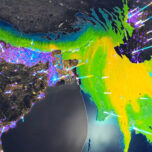April 22, 2020 — Imagine that it’s 2040, and we’ve reversed the extinction crisis that we were facing back in 2020.
Species counts are on the rebound in the oceans, on land and in the air. Crucial habitats are no longer being routinely turned into farmland or other uses unfriendly to biodiversity. There’s still plenty of work to do, but we can see light at the end of the tunnel — enough to know it isn’t the headlight of a train hurtling toward us.
How did we do it? What were the specific interventions and policies that turned things around from the near-dire state we’re in today?
As a conservation scientist, I think we know enough to identify the top priorities we should be pursuing:
- Invest corporate funds in biodiversity protection. This makes sense, considering the risks companies face to their supply chains and bottom lines when nature is degraded. Once industries invest in protecting biodiversity, it will quickly become part of the world’s business and financial markets.
- Mainstream the value of ecosystems and their services into national and subnational budgets, policy planning and implementation by “acknowledging that nature and nature-based solutions are the foundation of social and economic development,” as others wrote in Ensia. This will elevate biodiversity protection as a priority for many more policymakers.
- Include biodiversity protection in global sustainability goals, such as with the United Nations’ Sustainable Development Goals (SDGs) on agriculture and climate change, instead of isolating it in things like the Convention on Biological Diversity (CBD), which are less well known. Biodiversity is not only an explicit part of SDG 14 and 15, but also the foundation for all economies. Considering biodiversity inherent in all SDG goals will ensure it’s factored into sustainable economic development.
- Make significant progress on mitigating carbon emissions and prepare habitats for climate change impacts that are already baked into the system.
- Mitigate plastic pollution by focusing on scalable interventions in proper global waste management, instead of diverting attention and resources into things like plastic straw bans.
- Make sure conservation doesn’t exist in a vacuum. Biodiversity protection currently is largely the purview of the natural sciences, even though any approach that focuses on species or habitat restoration while socially or economically excluding local people is unlikely to succeed. More science is unlikely to yield outcomes unless that science is integrated into the socioeconomic context.
That’s a pretty short list. It won’t be enough to reach a 2040 in which we’re optimistic that we’ve turned the corner for biodiversity. We’re going to need many more proven interventions.
The big question is, which ones? There are lots of interventions that we’re trying or would like to try but for which we simply don’t have enough evidence to determine whether the results will be worth the costs, whether they can scale enough to make a big difference, or even whether they’ll work at all. Among them:
- Protected areas. Protected areas have been a key strategy for conservation organizations and national governments to advance biodiversity protection. However, according to a study published in PNAS last November, terrestrial protected areas haven’t on average reduced pressure on species over the past 15 years. What conditions are needed for protected areas to succeed? How do we maintain those conditions as the international community tries to rapidly scale up protected areas after the October 2020 convening of the CBD?
- Assisted migration. Ecologists have been debating transplanting species outside their native ranges for well over a decade. As the impacts of climate change accelerate and species’ native ranges dwindle, we still don’t know whether and in which cases the risks outweigh the benefits.
- Synthetic biology. Synthetic biology and engineered gene drives have been proposed for ridding islands of invasive rodents that compete with endangered species and for enhancing the resilience of species vulnerable to climate change. But because little of the investment currently pouring into synthetic biology goes to investigating how it might benefit conservation (instead it goes to food, ag, consumer products such as skin care restoratives, health care, industrial chemical production, gene editing innovations, and other non-conservation efforts), we don’t know whether it really could be a game changer.
To lengthen the list of strategies we do know will work, we need a different kind of approach than one only based in slow, peer-reviewed science.
We need a Project Drawdown for biodiversity.
Lessons from Project Drawdown
Project Drawdown is a research organization that “reviews, analyses and identifies the most viable global climate solutions, and shares these findings with the world.” The organization has produced a table ranking the most impactful 82 climate change solutions as measured by a single metric: total atmospheric CO2 reduction.
The conservation community needs a similar gold standard metric for assessing the impact of biodiversity interventions. And to pick it and create a table similar to Project Drawdown’s, we need to establish a robust evidence base similar to the one Project Drawdown has synthesized (see #5 on the organization’s list of Frequently Asked Questions to learn about its process).
Once a metric is picked, a Project Drawdown for Conservation should take several other pages from the original Project Drawdown.
First, Project Drawdown evaluates solutions by a wide range of criteria, including scalability, economic viability, size of impact and whether positive results will outweigh negative ones. Biodiversity conservation, which has for too long been focused on philanthropically funded solutions that cannot support themselves and that still too often have negative impacts on human communities, needs to think similarly about its interventions.
Second, Project Drawdown has been effective in communicating its solutions to broader audiences through a book, an interactive website and partnership outreach. Biodiversity conservation science needs to move beyond technical papers and reports so its solutions are more easily accessible to the private sector, civil society and the policymaking community.
Third, Project Drawdown is a living research project, committed to updating its recommended solutions with research on emerging interventions. A Project Drawdown for Conservation needs a similar ongoing commitment to review and test novel interventions, and to recommend the most promising ones for further large-scale testing.
Figuring Out What Works — Fast
A Project Drawdown for Conservation will require substantial resources and global buy-in. But without them, we’ll continue on our present course of slow science and the increasing marginalization of biodiversity. Getting to the planet we want in 2040 means figuring out what works and what doesn’t as fast as possible, and making the successful interventions standard operating practice for every sector on Earth. We need every major conservation organization, funder and donor pushing hard for the evidence base that could lead to a Project Drawdown for Conservation. Without it, 2040 will make 2020 look like a walk in the park. With it, we have a ray of hope for sustaining life on Earth into the future.
Editor’s note: The views expressed here are those of the author and not necessarily of Ensia. We present them to further discussion around important topics. We encourage you to respond with a comment below, following our commenting guidelines, which can be found on this page. In addition, you might consider submitting a Voices piece of your own. See Ensia’s Contact page for submission guidelines. In the interest of transparency, we note that editor in chief Mary Hoff met Leah Gerber while she was a journalism fellow at Arizona State University, where Gerber is a professor. The ideas in this article were improved based on discussions with Alex Dehgan, Paul Punje, Jon Foley, Bob Lalasz, Gwen Iacona, Hugh Possingham, Alice Letcher and Dan Miller.
Related Posts
Ensia shares solutions-focused stories free of charge through our online magazine and partner media. That means audiences around the world have ready access to stories that can — and do — help them shape a better future. If you value our work, please show your support today.
Yes, I'll support Ensia!


